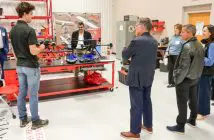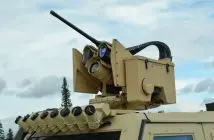
INTRODUCTION
This exploratory paper looks at the relationship between a Space Economy brought about by convergence of several building blocks based on a simple Input-Output Model. Four Space Economy building blocks are identified: (1) Exploiting a unique manufacturing environment; (2) Fundamental change in rocket transportation; (3) Shifting the launch cost equation from pound: kilogram per launch, to tons per launch; and, (4) Merging of Spaceports, and International Airports. The paper will look at the set-up of a Space Economy in terms of Space Industrialization, focusing on the manufacturing side, by looking at a notional Space Factory established to produce in Microgravity: Zerogravity high-value products. The paper will also look at how creating a Space Economy will likely create new economic entities: Space-Based Transnational Corporations. The paper will end looking at redefining Space Power and Defence of Space, and the role of a Space Force, and Soldier-Astronaut-Combatants.
THE SPACE ECONOMY AND DEFENCE IMPLICATIONS
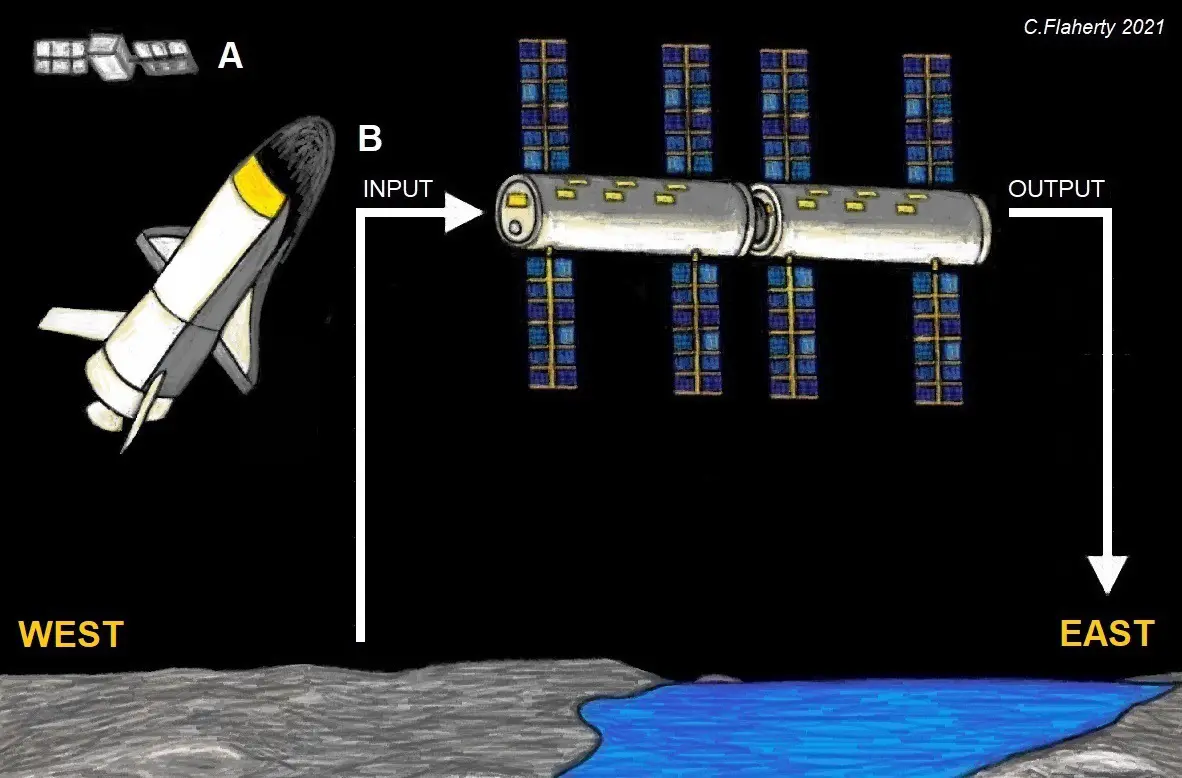
FIGURE 1: A Space Factory based on a simple Input-Output Model working on a continuous Eastward rotation of the Earth. In the background an enemy attack satellite deorbits (A). Nearby a Spaceplane manoeuvres to defend (B). The Space Economy model has Defence of Space implications. Namely, the notion that merged transport hubs on the Earth’s Surface, extend an economic system made from Lines of Communication, and Lines of Commerce into the Defence of Space conceived as a type of geography consisting of gravity, orbits, military lanes and lines.
Since 2017, the forward prediction for the Space Industry in the next 30 years, it will be worth globally between one and three trillion USD (Sheetz, 2017). In 2019, the global Space Economy grew to 423.8 billion USD, up from an estimated 345 billion USD in 2016 (Space Foundation, 2020). The global Space Economy in near-term, is forecast:
“as an investment theme … likely to impact a number of industries beyond aerospace and defence, such as … [information technology]… hardware and telecom sectors … [and]… could generate revenue of more than … [one trillion USD]… or more in 2040” (Morgan Stanley Research, 2020).
The global finance, trade, industry, and international banks have all made largely similar predictions for the value of the Space Economy, by the year 2040: 1 trillion USD (UBS); 1.1 trillion USD (Smith, 2018; Morgan Stanley Research, 2020); and, 1.5 trillion USD (Higgenbotham, 2018). The U.S. Secretary of Commerce projections place the 2040 global Space Economy at between one and three trillion USD, and will likely get to a trillion before 2030 (Ross, 2020). Traditionally, Space activities have largely been funded by government, however the commercial sector accounts for over three-quarters of the 323 billion USD spent yearly across the globe on space activity (Moltz, 2019). More recently, it has been noted, that while government activity in Space is growing, over 80 percent of the 415 billion USD Space Economy is commercial (Ross, 2020; Buehler, 2021). Ultimately,
“the future of Space is overwhelmingly commercial in nature, and will no longer be dominated by government agencies and their priorities.” (Ross, 2020; Buehler, 2021)
It has been calculated in early 2020 that in order to get into Space first, around one percent of Global GDP needs to be spent (Elon Musk: Air Force Association, 2020). At current estimates one percent of Global GDP is about 1.4 trillion, based on the 2019 total in International Dollars (Statista). However, it is suggested that more realistically, the spend of one percent of GDP is more likely to be per country – given the initial out-lays likely required for a radical and massive move to create the infrastructure needed for the new Space Economy. The major implication of such a massive and radical move introduces a new type of equation in the Defence of Space, creating a new type of dependency:
“society not only relies on Space capabilities, it expects the services they provide to always be present. Space enables our National Security to preserve our way of life. From protecting the homeland and fighting our nation’s wars alongside allies and partners, to providing Humanitarian assistance, Space makes the achievements of America’s military possible.” (USSPACECOM, 2021)
Societal dependency on its Space Infrastructure, and its need to protect this, with establishment of a Space Economy radically shifts along a trajectory, rather than the several centers of gravity currently seen in Space (Butow, 2020), the Space expanse becomes a super-center of gravity that needs to be defended. This set of issues will be examined at the end of this exploratory paper, looking at the Defence of Space.
EXPLOITING A UNIQUE MANUFACTURING ENVIRONMENT
The first of the Space Economy building blocks is exploiting a unique manufacturing environment. The notion of, “Space Industrialization” in the early 1980s was largely limited to, “domestic commercial exploitation of Space capabilities, technology, and systems for national economic benefit.” (Reis, 1984) Its central policy questions were: (1) Are there in fact products and processes which can be developed in Space which can make a real difference to the U.S. economy? and, (2) Is there enough so that a market can be created that is fair and competitive? The following discussion will examine these policy questions from a contemporary perspective, as both Space Technology, and the possibility of Space-Made products have vastly changed over the intervening decades.
Space Industrialization is linked to the notion of, “Complexity Inversion” (Gould, 1978). Complexity Inversion is where initially the bulk of a system at its Space-End is small and light.
The corresponding ground segments are massive and complex. Advances in technology, and keeping within reasonable launch cost limitations, the reverse of this situation becomes feasible to make the Space segment vastly more capable and complex. Complexity Inversion was originally conceived in relation to creating a Space-Based Information Infrastructure; however, the notion is equally germane to a Space Factory concept, based on a simple Input-Output Model, as the basis of a future Space Economy (see FIGURE 1).
Space industry largely envisages activities such as: Lunar and asteroid mining, and Space tourism (Ross, 2018; Buehler, 2021). A factor likely to drive the Space Economy is the search for elements not freely available on Earth. On the Earth’s Moon, an element like Helium-3 (that has possible energy uses) is more available (Berthold, 2021). Recent confirmation of the small cyclic molecule Cyclopropenylidene: that may help form precursors to life,
“[is]… the first detection on Titan … [Saturn’s Moon] … and the first time this molecule has been detected in a planetary atmosphere” (Crane, 2020; Nixon, 2020).
The scale of Earth’s Moon mining could be limited (as with other worlds) as it is not known how and when Planetary Protection environment issues will start to kick-in, affecting how extensive an operation is. In relation to mining the Earth’s Moon, it is currently understood:
“even if the Moon lost just … [one percent]… of its total mass, this still would not significantly affect its orbit, or the gravitational pull on Earth’s oceans that causes high and low tides.” (Berthold, 2021)
However, there would still be a question as to how much Moon rock and regolith could be processed, or water removed before we start to see changes given the potential scale of mining operations that could be set-up, based on comparisons with surface mining on Earth. For instance, the Committee of Space Research’s Planetary Protection Policy (PPP) seeks protection of the Space Environment from, “harmful contamination”, which in the main is trying to avoid endangering the integrity of the scientific exploration of Outer Space including the search for life (COSPAR, 2020; Cheney, 2020). In essence, a type of normative rights for protection of alien life (upon its contact with Human explorers), exists under the concept of,
“Planetary Protection … [that]… is critical for enabling scientists to study the natural environments of celestial bodies without interfering with possible life forms that may have developed there.” (Cheney, 2020)
This reflects the notion, of a need for a broader environmental perspective namely the concept of a necessity to protect the Outer Space as an environment in its own right (Cheney, 2020). Environmental issues could include how mining could change the appearance of the Moon, for the first time in Human history, which could have profound cultural and religious implications.
Space Industrialization: Materials Processing in Space
Space Industrialization has also been conceived in terms of, “materials processing in Space” (Marshall, 1984). Space Industrialization has been linked since its earliest conception to manufacture in orbit using terrestrial materials, materials from the Moon, or materials from outside Cislunar Space (Gould, 1978). Taking the original NASA ‘Microgravity: Zerogravity Materials Processing in Space Program’ as a point of departure, its economic justification was:
“There is the potential for large stable markets for high-value, low-mass items and materials (particularly for use by health, electronic, and defence related activities) which require the special environment of Space for their processing.” (Marshall, 1984)
In a contemporary context, the following list of three exemplar industrial-manufacturing activities, for extreme high-value commodities, illustrates types of Space Industrialization materials processing that could be likely manufactured in a Microgravity: Zerogravity environment:
| ZBLAN Optical Fiber | Drawn fluoride glass. This product has superior transmittance, and offers higher bandwidth for signal transmission. |
| Biological 3-D Printing | Biological 3-D printed Human replacement organs, made from a doner patients own stem cells found in most adult tissues, such as bone marrow or fat. |
| Gallium Arsenide Solar Cell | Super-efficient solar panels based on Gallium Arsenide. Manufacturing produces toxic by-products such as Arsenic. Its manufacture in Space allows a higher quality. The compound in a vacuum environment can be grown in neat defect free layers. |
Sources: Various.
Space Factory
The Space Factory concept is based on a simple Input-Output Model. Two phenomenon dictate its operation: (1) Earth’s prograde rotation; and, (2) Greater speed of an orbital object around the Earth. Launching a rocket towards the East, gains a boost from Earth’s rotational motion saving fuel, which reduces launch costs (see FIGURE 1). A Space Factory would act the same way as the current International Space Station (ISS), orbit about every 90 minutes, and over a 24 hour-period make approximately 16 orbits of the Earth (during its rotation). Space Factories coming overhead are served by rockets taking-off delivering raw materials. Second stage craft landing cargo bring down product from the Space Factories. Which is then unloaded into waiting aircraft, rail and road transports. The simple Input-Output Model, following the Earth’s prograde rotation would likely require a system of planetary-ring Global Launching-Landing Points, some on land, others on floating facilities, to be set-up in order to keep-up continuous servicing and receiving from Space Factories coming overhead. It is likely the system, supporting the Space Factory concept will be based on the two stage rocket, a returnable booster first stage, and second cargo carrying stage capable of controlled vertical landings. It is likely, there would be two versions, one for point-to-point transportation via Space, and one to deliver materials, and crew to Space Factories in orbit. The same second stage module will likely be able to dock at the input-end of a Space Factory, to unload, and then manoeuvre to the output-end of the Space Factory to load product for delivery back on Earth.
The notion of Space manufacturing by new Space companies is seen as one economic avenue for, “bringing revolutionary products to the marketplace, which is shifting Space Power leadership back toward the … [U.S.]” (Moltz, 2019). Space manufacturing, has been related to private commercial operation of a 3-D printer on the International Space Station (ISS), and Space Construction by private commercial activity:
“working toward the capability to build and robotically assemble large structures in orbit, thus drastically reducing construction costs.” (Moltz, 2019)
In this exploratory paper, the Space Factory concept uses a plan not unlike the original NASA Skylab, its hull was a converted third stage on the Saturn V, and second stage on the Saturn IB launch vehicles, used to make the Orbital Workshop configuration. It should be noted that the original idea of a Space Factory,
“[was]… the Space Shuttle-Spacelab combination … [providing]… an early first step toward a general-purpose manufacturing … [research and development]… facility.” (Gould, 1978)
It was envisaged that one of the potential uses of the Space Transportation System – Space Shuttle included, “[its]… availability as a Space manufacturing facility for commercial activities (Hosenball, 1984). The later NASA Space Station concept was also seen, “as part of an industrial system which supports Space Industrialization” (Marshall 1984). It is speculated that a fully usable manufacturing unit within a hull of similar dimensions to the current second stage of a SpaceX Starship could be launched; these have a length of 50 meters: 160 feet, with a diameter of 9 meters: 30 feet, and a payload capacity of 100 tons (SpaceX). Lifted by a reusable vertical Super Heavy First Stage Rocket. Complete factories could be put into Low Earth Orbit immediately, and larger facilities could be several of these connected together.
FUNDAMENTAL CHANGE IN ROCKET TRANSPORTATION
FIGURE 2: Looks at several economic factors effecting a transport revolution. The average cost of a rocket launch in 2012 was around 57 million USD (Chaikin, 2012). However, by 2019 it was anticipated that the cost of a rocket launch could fall to around 2 million USD (Wall, 2019).
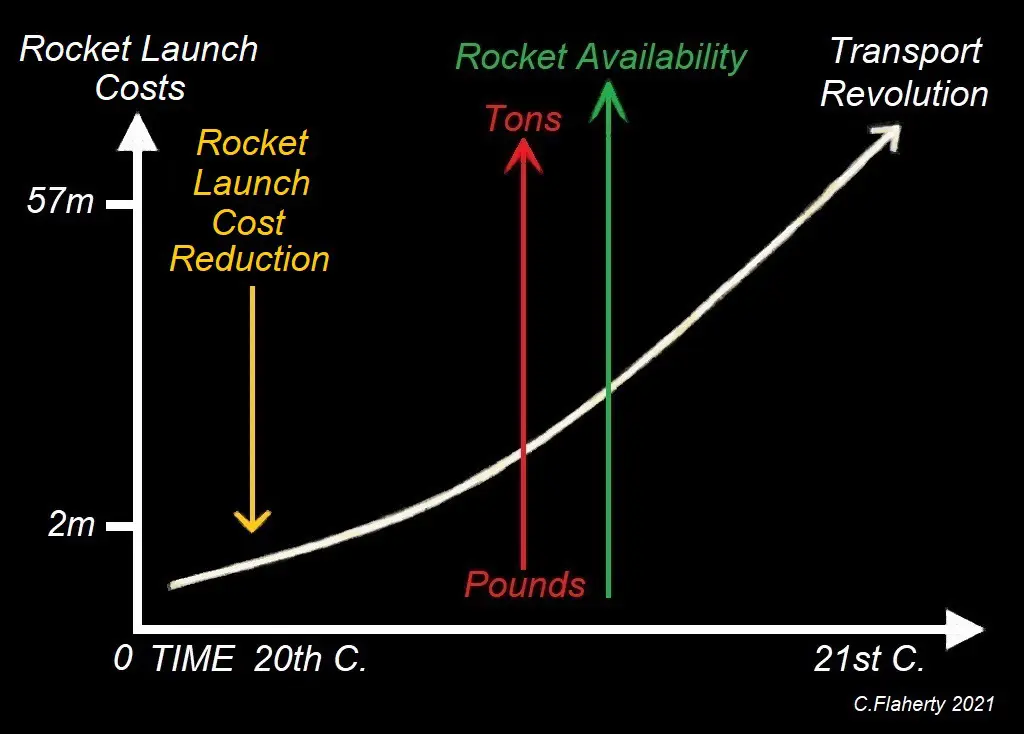
“FIGURE 2: A Table showing several economic changes effecting the set-up of the Space Economy.”
The Space Factory concept is useful to introduce a set of notional constructs for how achieving the first setup of a Space Economy could be implemented through the building block of a fundamental change in the mode of rocket transportation. Based on radical innovation, and being the first to do so:
“will definitely require radical innovation … one … [cannot]… get there by incrementally innovating … we need to push for radical breakthroughs … and if you … [do not]… push for radical breakthroughs you are not going to get radical outcomes” (Elon Musk: Air Force Association, 2020).
It should be noted, that if innovation does not occur a country, is both economically and militarily liable to loose-out competitively:
“to be competitive on a military level … innovation has to overcome a gigantic gap in economic output … [from a competitor country]… in the absence of radical innovation the U.S. will be militarily … second” (Elon Musk: Air Force Association, 2020).
The new Space Economy will be largely a product of an historical transformation in Space Transportation. Earth distances and travel time are massively reduced, using point-to-point rocket transportation. A key economic argument is that further depression of the cost of a rocket launch, is a radical shift based on full reusability,
“important for leadership in Space … I … think … [it is]… absolutely fundamental to achieve full reusability and access to Space … [if]… you have full reusability for orbital rockets then you have a profound advantage over anyone else” (Elon Musk: Air Force Association, 2020).
Effecting a transport revolution, along with the falling cost of a rocket launch, is the increasing capacity of rockets to lift cargo (increasing it radically from pounds: kilograms to tons). Along with downwards cost pressure, is greater rocket availability. Greater rocket availability is also the product of a changed production system that is able to churn-out large numbers of rockets adding to the capacity to mass transport items, and those rockets are completely reusable:
“[to create]… a fully reusable system and having that be in volume production and volume launch … [of the rockets, and]… just like an aircraft … the rocket must be rapidly and completely reusable and then you need lots of them” (Elon Musk: Air Force Association, 2020).
Mass availability, cheap launching and reusable rockets for point-to-point travel on Earth largely solves the basic Space transport problem, bringing about a revolution likened to the original construction of the Union Pacific Railroad:
“once you have a dramatically lower cost access to Space then many things are able … [to]… think of like once … [you have]… got the Union Pacific Railroad then you know getting to the … [U.S. West Coast] … much faster and … [with]… much less … [danger]” (Elon Musk: Air Force Association, 2020).
SHIFTING THE LAUNCH COST EQUATION
A radical drop in the cost of a rocket launch is a major building block leading to the set-up of a Space Economy. Historically speaking the general rule has been:
“After an initial decline at the beginning of the Space Age, Western launch costs have remained very high and relatively constant until recently … [these]… high launch costs have been the greatest limiting factor to expanded Space exploitation and exploration.” (Wertz, 1996; Jones, 2018)
It is largely essential to shift the usual launch cost per pound: kilogram to Low Earth Orbit, to launch cost per ton, in order to achieve true economies of scale, and then, “[having]… a launch system that is somewhere in the megaton per year range” (Elon Musk: Air Force Association, 2020).
MERGING SPACEPORTS AND INTERNATIONAL AIRPORTS
Most international airports currently have commercial runways that could accommodate both conventional aircraft and Spaceplane landings. For example, Sydney International Airport has its main runway length at around 3,962 meters: 12,998 feet (Sydney Airport). This could currently accommodate a returning Spaceplane, like the Dream Chaser that can land at any suitable runway of 8,000 feet: 2,400 meters long, around the world without requiring specialized equipment (Taylor, 2014).
Merged Spaceports – International Airports, are the last building block for a Space Economy to be set-up. These will have rocket launch facilities, and landing pads for cargo rockets capable of controlled vertical landing servicing the Space Factories. The same rocket launch facilities, and landing pads would also service point-to-point cargo rockets. Currently, the merger has begun. For instance, in the UK, Glasgow Prestwick Airport has sought interest from companies in carrying out horizontal Space launches from its 2,986 meters: 9,796 feet long concrete case runway (BBC, 2020). This is part of a commercial plan – The Ayrshire Growth Deal document:
“investment will be a catalyst to establishing Glasgow Prestwick Airport as the leading horizontal launch Spaceport in Europe, providing a range of services including Micro gravity flights, air launch of satellites, Human Space flight and hypersonic flight services.” (Hilley, 2020)
SPACE-BASED TRANSNATIONAL CORPORATIONS
Creating a Space Economy will create new economic entities, and these will likely operate as Space-Based Transnational Corporations, legally incorporated in much the same way that shipping companies operate under International Law that requires every ship be registered in a country, called its flag state. This concept, is already starting to take shape, as the U.S. Government has a stated objective, “to remain the flag of choice for commercial Space firms” (Ross, 2019; Buehler, 2021). Conversion from the 1967 Outer Space Treaty into,
“modern International Space Law … makes states responsible for the activities of their nationals and private corporations in Outer Space and requires that they ‘authorize’ and ‘continually supervise’ those activities. Similarly, Article VIII establishes that the state on whose registry a Space Object is carried ‘retains jurisdiction and control’ over the Space Object and its personnel.” (Cheney, 2020; United Nations)
One of the most significant global economic activities, will likely be a number of companies building multiple but similar systems that can effectively and seamlessly interoperate, in order to accelerate the advent of the first setup of the Space Factory. In particular, its integration into national and global transportation systems for multiple point-to-point launching and landing ports, including airports, and transport-distribution hubs. Space Factories will be new economic actors, legally tethered to their state of registration, operate globally, in orbit around the Earth, rotating every 90 minutes, on a planet on its own 24-hour rotation. From the perspective of a country, its Space Economy will not be attached to any geographical location on the Earth’s Surface, rather it is part of a much broader Space-Based Infrastructure, that all countries are increasingly dependent. In orbit around the Earth, as it spins on its own axis. Expanded further, this will also connect to a global system of Ground Control Stations.
The revolving nature, and separation of the Space Domain from the Terrestrial Domain: Theatre Separation (Flaherty, 2020), combined with the simple Input-Output Model as the basis of a Space Economy leads to a concept for the Defence of Space based on three largely shared notions: Lanes of Commerce, Lines of Communication, and Lines of Operation. This will be examined next in this exploratory paper.
REDEFINING SPACE POWER AND THE DEFENCE OF SPACE
The Space Economy building blocks: (1) Exploiting a unique manufacturing environment; (2) Fundamental change in rocket transportation; (3) Shifting the launch cost equation from pound:
kilogram per launch, to tons per launch; and, (4) Merging of Spaceports, and International Airports, effectively reshape the notion of Space Power:
“In the twenty-first century, a new form of bottom-up, net-centric, commercially led Space innovation is emerging that promises cheaper and more timely technological developments to those nations that can effectively tap into them, thus reshaping traditional definitions of Space Power.” (Moltz, 2019)
In the early Space Age, the legal standing of the Space Transportation System – Space Shuttle was one, “treated as a national resource.” (Hosenball, 1984) As it could be made available to a variety of customers, public and private, for a wide range of uses in Space,
“[as]… a true Spaceborne laboratory or facility for the conduct of experiments, demonstrations, and even ongoing commercial operations for Space manufacturing.” (Hosenball, 1984)
Seen as a national resource, largely necessitates the need to defend, or police from the owner nation’s perspective. The question becomes – what form would this take? It could be argued that a radical shift in the set-up of a Space Economy, that its building blocks, like the merged transport hubs on the Earth’s Surface, extend an economic system made of Lines of Communication, and Lines of Commerce into the Defence of Space, similarly conceived as a type of geography consisting of gravity, orbits, military lanes and lines.
The major conceptual shift is from, viewing Earth from the high-ground of Space, to looking at the Earth as part of a greater expanse. The prevailing consensus in the Defence of Space is, “treating the Space environment as just another geography.” (Dolman, 2002) The type of geography consists of gravity, orbits, military lanes and lines. However, that geography has to be viewed from two perspectives: the perspective from Earth’s Surface, and the perspective from a point in Space. The perspective from the Earth’s Surface has always recognized movement as a fundamental element in combat:
“Sun, stand still at Gibeon, and Moon, in the valley of Aijalon … And the sun stood still, and the Moon stopped, until the nation took vengeance on their enemies.” (Joshua)
The fundamental experience of Human Terrestrial Warfare, is the battle begins with the rising Sun, and ends with nightfall. The Defence of Space represents a massive conceptual shift in how we view movement, and manoeuvre: all is in rotation. Space-to-Space Combat in Earth Orbit, would in any point in Space be in orbit around the Earth, acting much the same as the current International Space Station (ISS) orbit about every 90 minutes, and over a 24 hour-period makes approximately 16 orbits of the Earth (during its rotation). Effectively, the Space Combat Zone is in an orbit speed greater than the Earth’s rotation, and in relation to Earth-Based Combat is notionally known as Theatre Separation (Flaherty, 2020). The notion of Theatre Separation arises in the relationship between Space-Based Weapons, and Terrestrial-Based Forces. Traditionally, these have been viewed part of coordinated, and sequenced actions by diverse components set by a specific geographical context, underpinning the political aims of the conflict (Preston, 2002).
Notionally, the Theatre is a geographical location where Terrestrial-Based Forces are available, or must be relocated to; and where Space-Based Weapons are brought to bear. This gives way to the notion of a constantly revolving planet, around which there are faster orbiting Space-Based Forces that can attack Targets in Space, in the Earth’s Atmosphere, or on its Surface (as these come overhead, and come into attack range). It can also be anticipated that in order to defend a portion of the Earth’s Surface, it does not necessarily mean that the Forces needed to do so, are located on the Surface. Instead these could operate at Extreme High-Altitudes, or operate from Space – the object being to attack Targets from above, or from Low Earth Orbit. Figuring-in the ‘new’ Space geography of gravity, orbits, military lanes and lines, can be illustrated in simple terms, in relation to the new Space Economy, with the illustration used at the beginning of this exploratory paper showing a basic attack-defence scenario involving a Space Factory: (A) Attacking enemy satellite deorbits; and, (B) A nearby Spaceplane manoeuvres to defend (see FIGURE 1). The model reflects the notion:
“several centers of gravity central to great power competition in Space: Space Transportation and Logistics; In-Space Power; Space resources and manufacturing; and the supporting policy and financial tools.” (Butow, 2020)
It can be argued that the several centers of gravity in Space, effectively in the Space expanse coalesce into a super-center of gravity. This is the result of the dependency (discussed earlier in this exploratory paper) any country now has, completely reliant on its Space-Based Infrastructure. From a National Security perspective all countries, regardless of their distance on the Earth’s Surface become front-line states automatically in any potential conflict. This necessitates military power projection into Low Earth Orbit, and ultimately Outer Space.
The Space Factory (and the Space Economy) based on the simple Input-Output Model, based on its economic lanes, and lines largely prefigures a military dependency on its: “future Lanes of Commerce and military Lines of Communications in Space” (Dolman, 2002). These military lanes and lines themselves crucially connect to, “Hohmann transfer orbits between stable Spaceports.” (Dolman, 2002) In orbital mechanics, the Hohmann transfer orbits: an elliptical orbit used by a craft to transfer between two circular orbits of different radii around a central body in the same plane. The Hohmann transfer often uses the lowest possible amount of propellant in traveling between these orbits.
“because of gravity wells and the forbidding cost of getting fuel to orbit, over time Spacefaring nations will develop specific pathways of heaviest traffic. Each of these pathways, identified later in the astropolitical model as Hohmann transfer orbits, can be shown to have or to be in themselves critical chokepoints. The state that most efficiently occupies or controls these positions can ensure for itself domination of Space commerce and, ultimately, terrestrial politics.” (Dolman, 2002)
The Defence of Space is based on similar lanes and lines to those used in the economic sphere, such as “physical goods traversing Lines of Commerce” (Buehler, 2021). Which have both military and economic functions. Translated into a military concept,
“from the perspective of Space systems, the most important among these concepts are Lines of Communication … [and]… Lines of Operation” (Drew, 2020).
Military lanes and lines: Lines of Operation, feeds into a broader construct involving the gravity spheres – the Earth, its Moon, and Mars. Notionally called, the: “3-Body Effects” (Buehler, 2021), is based on the concept,
“[that]… emphasizes orbits, regions of space, and launch points as geopolitically vital assets over which states can be expected competitively and strategically to struggle for control.” (Havercroft, 2009)
Case-study assessments of the actual technology of Space-to-Space War – using a kinetic attack by a Satellite, show this would be heavily constrained by the limits physics imposes on movement in Space, and the limitations imposed by time:
“[requiring]… deliberate … [planning]… with Satellites manoeuvring for days, if not weeks or months, beforehand to get into position to have meaningful operational effects. But once an orbital threat has matched planes and set-up the timing through precise orbital phasing, many opportunities can arise to manoeuvre close enough to engage a target quickly.” (Reesman, 2020)
The prevailing thinking about a Space-to-Space War, or Space-Based Battle its function would be to serve undertaking a Control-of-Space Campaign, the object being:
“is not necessarily to physically conquer sectors of Space but rather to reduce or eliminate adversary Satellite capabilities while ensuring one retains the ability to freely operate their own Space capabilities.” (Reesman, 2020)
THE SPACE FORCE AND SOLDIER-ASTRONAUT-COMBATANTS
The radical shift of large numbers of Humans into off-world science, and economic activities to name a few, fundamentally changes one of the major assumptions about the conduct of a near-future Space-to-Space War, or Space-Base Battle, namely:
“one of the key differences of Space Warfare, at least for the near future, will be the spatial separation of Human combatants from their weaponry.” (Ramey, 2000)
Reintroduction of Human, and robotic combatants with their weaponry, operating in Space is likely an outcome. It should be noted that the current actual U.S. Army Astronaut Detachment maintains a small group of, “Soldier Astronauts” (U.S. Army, 2018). The Detachment’s role,
“[is to support]… NASA with flight crew members and … [provide]… engineering expertise for human interface with Space systems” (U.S. Army, 2020).
Creation of a Soldier-Astronauts category is not just historical, in terms of the military association with the formation of the early Space Program, it is also driven by the Laws of War, which have created the notion of the Astronaut-Combatant:
“A necessary precondition for any Astronaut claiming combatant status … As applied to Space Warfare, this might mean that a combatant who enters an opposing Spacecraft cannot be considered a spy as long as his vessel bears its prescribed distinctive markings, and the Astronaut wears his military uniform.” (Worden, 2002)
As a corollary, the 2020 announcement was made that personnel in the U.S. Space Force will be called Guardians (Garamon, 2020). Likely chosen to achieve a less military-sounding role, in keeping with the requirement to keep in step with an ongoing demilitarization of Space.
Space Force Roles
A Space Force will need to operate along a spectrum: military force, police, commerce authority, and coast guard in Low Earth Orbit, Cislunar and Mars Space. Broadly, analogous to ancillary humanitarian, and aid to civil authorities roles played by the U.S. military globally:
“frequently asked to prevent loss of life or property, or to help in recovery from natural or man-made hazards such as humanitarian relief operations, non-combatant evacuation operations, rescue, and assistance at sea. In keeping with these non-core, but traditional military roles, as commercial activity moves further into Space, military Space Forces will likely be called upon to provide similar support to commercial actors and scientific missions.” (Buehler, 2021)
The 1967 Outer Space Treaty has broadly banned the stationing of Weapons of Mass Destruction in Outer Space, and prohibited military activities on celestial bodies (United Nations). The basic posture has been, “responsible, peaceful, and safe use of Space.” (USSPACECOM, 2021) However, a radical and massive technology shift in transportation allowing a large-scale Space Economy to set-up Space Factories, and permanent Human presence on the Earth’s Moon, and Mars fundamentally shifts the basic gearing underpinning the 1967 Outer Space Treaty. A practical necessity emerges, “[to]… protect and defend … against any foreign Space-related aggression … [in Space itself].” (USSPACECOM, 2021)
Companion Robotic Astronaut-Soldier
A companion Robotic Astronaut-Soldier, is a growing possibility (Flaherty, 2021). Since 2000, including currently, research and development programs have built several bipedal Humanoid-looking Astronaut’s assistant robots.
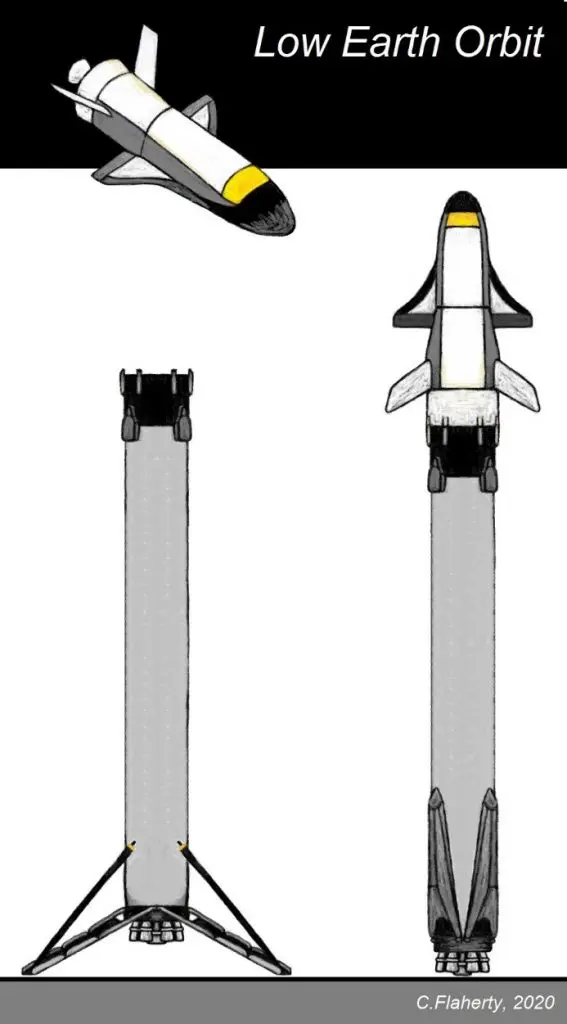
“A concept for an Nth-Generation Fighter: Orbital Spaceplane. It launches from the Earth’s Surface with a returnable booster rocket. Conducts a mission in Low Earth Orbit, and then flies back to Earth to land on a runway.”
Examples include the NASA Robonaut Project (NASA, 2019); and, Russian F.E.D.O.R. Platform (Androidnaya Tekhnika, 2019). The aim has been to build a robot that can do the same jobs as a Human. Whether Soldier-Astronaut-Combatants, or robotic companions, are used in the Defence of Space, the type of craft they are likely to operate and crew will be discussed next.
Nth Generation Space Fighter
The basic vision of a Space Force is one capable of armed response, with fuel tankers, and armed craft operating in Low Earth Orbit, Cislunar and Mars Space. A number of specialised Space Force craft are envisaged, such as a Cislunar Highway Patrol Vehicle, or a Moon-Local Observation-Inspection Spacecraft, with manoeuvre capability (Erwin, 2020; Buehler, 2021). The possibility also exists for Nth-Generation Fighters: Orbital Spaceplanes launched into Low-Earth Orbits using vertical first-stage booster rockets to be built (see RIGHT; Flaherty, 2020).
Orbital Spaceplanes are currently being built however none are intended for combat roles. For instance, the Boeing X-37: X-37B (discussed below), have a great-deal of secrecy surrounding it, and its payloads, spawning rumours it could be a space weapon (Wall, 2020). Nevertheless, the X-37B official use:
“[is for]… technologies being tested in the program include advanced guidance, navigation and control, thermal protection systems, avionics, high temperature structures and seals, conformal reusable insulation, lightweight electromechanical flight systems, advanced propulsion systems, advanced materials and autonomous orbital flight, reentry and landing.” (U.S. Air Force, 2020)
BELOW: The Dream Chaser (Sierra Nevada Corporation), is an Orbital Spaceplane designed to carry up to seven crew, or the same weight in cargo. Launched by a vertical take-off booster rocket into Low Earth Orbit. It returns flying back, to land on a commercial runway, that is 8,000 feet: 2,400 meters long (Taylor, 2014). The craft is 30 feet: 9 meters long. Its wingspan is 22.9 feet: 7 meters (14.7 feet: 4.5 meters with folded wings). Its height is 6.5 feet: 2 meters.
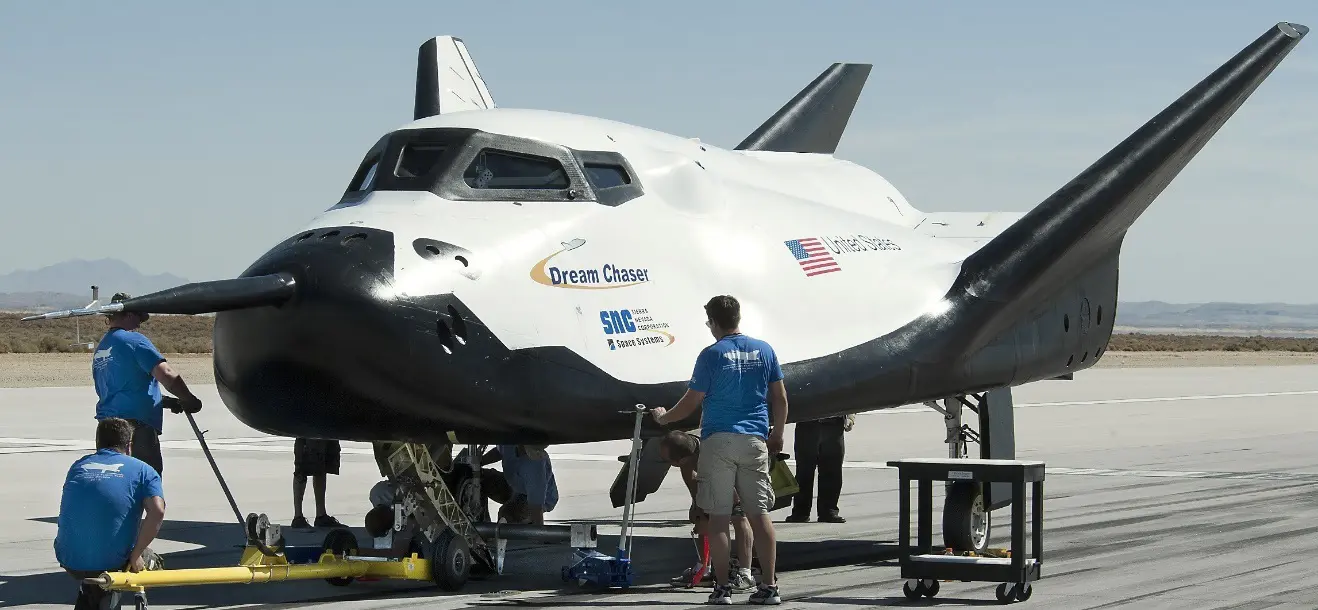
Source: Ulbrich, 2013.
BELOW: The X-37B is another example of a contemporary Orbital Spaceplane. Like the Dream Chaser it is designed to be launched into Space using a vertical first stage booster rocket, and fly-back to land on a runway. This smaller robotic craft is 29 feet, 3 inches: 8.9 meters long; it is 9 feet, 6 inches: 2.9 meters high; it has a wingspan of 14 feet, 11 inches: 4.5 meters; it weighs at launch, around 11,000 pounds: 4,990 kilograms (Wall, 2020; U.S. Air Force, 2020). The X-37B payload bay is about the size of a pickup truck bed.
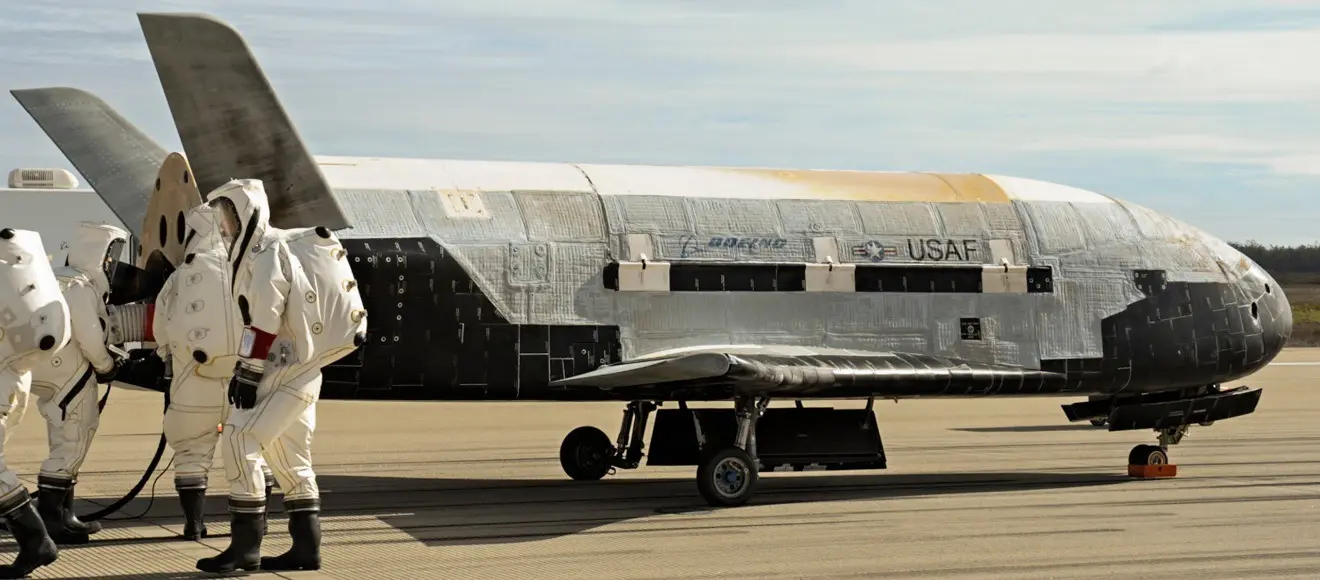
Source: Boeing, 2014.
REFERENCES
- Air Force Association. 2020 Keynote-Fireside Chat Between Elon Musk and Lt Gen John F. Thompson. Air Warfare Symposium. Orlando, Florida (February 26-28).
- Androidnaya Tekhnika. 2019 [-2015] F.E.D.O.R. Platform.
- BBC News. 2020 Why is Scotland a Prime Rocket Launch Site? BBC News Website (19 November).
- Berthold, E. Horner, J. Tucker, B. 2021 [-2018] Mining the Moon. Australian Academy of Science.
- Boeing Corporation. 2014 Photograph. X-37B Orbital Reusable Spaceplane. Landed at Vandenberg Air Force Base (17 October).
- Buehler, D. Felt, E. Finley, C. Garretson, P. Stearns, J. Williams, A. 2021 Posturing Space Forces for Operations Beyond Geo. Space Force Journal. Issue 1 (31 January).
- Butow, S.J. Cooley, T. Felt, E. Mozer, J.B. State of the Space Industrial Base 2020: A Time for Action to Sustain U.S. Economic & Military Leadership in Space Summary Report. Department of Defense (July).
- Chaikin, A. 2012 Is SpaceX Changing the Rocket Equation? Air & Space Magazine (January).
- Cheney, T. Newman, C. Olsson-Francis, K. Steele, S. Pearson, V. Lee, S. 2020 Planetary Protection in the New Space Era: Science and Governance. Frontiers in Astronomy and Space Sciences (13 November).
- Committee of Space Research (COSPAR). 2020 Policy on Planetary Protection. COSPAR Panel on Planetary Protection. Approved by the COSPAR Bureau (17 June).
- Crane, L. 2020 Weird Ring-Shaped Molecule on Titan Could be a Building Block to Life. New Scientist (30 October).
- Dolman, E.C. 2002 Astropolitik: Classical Geopolitics in the Space Age. Frank Cass.
- Drew, J.V. 2020 Space Operations: Lines, Zones, Options, and Dilemmas. Joint Forces Quarterly. Issue 99. 4th Quarter.
- Erwin, S. 2020 Moon Patrols Could be a Future Reality for Space Force. Space News (2 November).
- Flaherty, C. 2021 Inverted Combat in Space (8 January). Available on Linkedin.
- Flaherty, C. 2020 Spherical Tactics in Space (15 October). Available on Linkedin.
- Garamon, J. 2020 Space Force Personnel to be Called Guardians. U.S. Department of Defense News (19 December).
- Gould, C.L. 1978 Large Scale Human Benefits from the Industrialization of Space. The Space Congress. Proceedings.
- Havercroft, J. Duvall, R. 2009 The Geopolitics of Space Control and the Transformation of State Sovereignty. Bormann, N. Sheehan, M. (Editors) Securing Outer Space: International Relations Theory and the Politics of Space. Routledge Critical Security Studies.
- Higgenbotham, B. 2018 The Space Economy: An Industry Takes Off. U.S. Chamber of Commerce (11 November).
- Hilley, S. 2020 Prestwick Airport to Launch Human Space Flights as Money for Venture Pours In. Daily Record (20 November).
- Hosenball, S.N. 1984 Legal Considerations and Cooperative Opportunities for Space Commercial Activities. Second Symposium on Space Industrialization. NASA Conference Publication 2313.
- Jones, H.W. 2018 The Recent Large Reduction in Space Launch Cost. 48th International Conference on Environmental Systems ICES (8-12 July).
- Joshua [Book of]. Chapter 10: Verses 12-13 (Bible: New Revised Standard Version).
- Marshall, W.R. 1984 Role of Space Station – The How of Space Industrialization. Second Symposium on Space Industrialization. NASA Conference Publication 2313.
- Moltz, J.C. 2019 The Changing Dynamics of Twenty-First-Century Space Power Journal of Strategic Security. Volume 12. Number 1.
- Morgan Stanley Research. 2020 [-2018] Space: Investing in the Final Frontier. Morgan Stanley Website (24 July).
- NASA. 2019 Robonaut 2. Fact Sheet.
- Nixon, C.A. 2020 Detection of Cyclopropenylidene on Titan with ALMA. The Astronomical Journal. Volume 160. Number 5 (15 October).
- Preston, R. Johnson, D.J. Edwards, S.J.A. Miller, M.D. Shipbaugh, C. 2002 Space Weapons, Earth Wars. RAND Corporation.
- Ramey, R.A. 2000 Armed Conflict on the Final Frontier: the Law of War in Space. The Air Force Law Review. Volume 48.
- Reesman, R. Wilson, J.R. 2020 The Physics of Space War: How Orbital Dynamics Constrain Space-to-Space Engagements. The Aerospace Corporation (October).
- Reis, V.H. 1984 Space Industrialization – A National Perspective. Second Symposium on Space Industrialization. NASA Conference Publication 2313.
- Ross, W.L. 2020 A New Space Race: Getting to the Trillion-Dollar Space Economy. World Economic Forum. Davos, Switzerland (24 January).
- Ross, W.L. 2019 Remarks by U.S. Commerce Secretary. Sixth National Space Council Meeting. U.S. Department of Commerce (20 August).
- Ross, W.L. 2018 A Bright Future for U.S. Leadership of Space Commerce. U.S. Department of Commerce (21 February).
- Sheetz, M. 2017 The Space Industry Will be Worth Nearly $3 Trillion in 30 years, Bank of America Predicts. CNBC (31 October).
- Smith, R. 2018 The $1.1 Trillion Space Industry Prediction You Can’t Afford to Miss. The Motley Fool Website (16 February).
- Space Foundation [Editorial Team]. 2020 The Space Report. Space Foundation Website.
- SpaceX. Vehicles: Starship. SpaceX Website.
- Statista. Global Gross Domestic Product (GDP) from 2009 to 2019. Statista Website.
- Sydney Airport. Facts and Figures.
- Taylor, F.W. Allison, C.J. Lee, C.L. 2014 Challenges and Opportunities Related to Landing the Dream Chaser Reusable Space Vehicle at a Public-Use Airport. Space Traffic Management Conference. Sierra Nevada Corporation.
- UBS. 2018 Longer Term Investments: Space. UBS Website.
- United Nations Office for Outer Space Affairs (UNOOSA). Resolution Adopted by The General Assembly 2222 (XXI). Treaty on Principles Governing the Activities of States in the Exploration and Use of Outer Space, Including the Moon and Other Celestial Bodies.
- Ulbrich, K. 2013 Photograph. The Dream Chaser. NASA Media Archives (13 August).
- U.S. Air Force 2020 X-37B Orbital Test Vehicle. Fact Sheet.
- U.S. Army. 2020 United States Army Astronaut Detachment. U.S. Army Space and Missile Defense Command Public Affairs Office.
- U.S. Army. 2018 The Army Has Three Active-Duty Soldier-Astronauts. Mighty Tactical. We Are the Mighty Website (1 November).
- USSPACECOM [U.S. Space Command]. 2021 Never a Day Without Space: Commander’s Strategic Vision (January).
- Wall, M. 2020 X-37B: The Air Force’s Mysterious Space Plane. Space.Com Website (15 May).
- Wall, M. 2019 SpaceX’s Starship May Fly for Just $2 Million Per Mission, Elon Musk Says. Space.Com Website (6 November).
- Wertz, J.R. Larson, W.J. (Editors) 1996 Reducing Space Mission Cost. Space Technology Series. Kluwer, Dordrecht.
- Worden, S.P. Shaw, J.E. 2002 Whither Space Power? Forging a Strategy for the New Century. Fairchild Paper (September).
AUTHOR
Chris Flaherty authored the Terrorism Research Center’s report – Dangerous Minds (2012). He was the co-primary author, along with Robert J. Bunker of the book – Body Cavity Bombers: The New Martyrs (iUniverse, 2013). Two essays of his, from 2003 and 2010 were reprinted in the Terrorism Research Center’s book – Fifth Dimensional Operations (iUniverse, 2014). He recently contributed a book chapter – The Role of CCTV in Terrorist TTPs, edited by Dave Dilegge, Robert J. Bunker, John P. Sullivan, and Alma Keshavarz, the book – Blood and Concrete: 21st Century Conflict in Urban Centers and Megacities, a Small Wars Journal anthology, published on behalf of the Small Wars Foundation with Xlibris (2019).
 Chris Flaherty is currently a Space & Defense Tech and Security News Regular Contributor.
Chris Flaherty is currently a Space & Defense Tech and Security News Regular Contributor.
CONTACT DETAILS: Dr Chris Flaherty https://au.linkedin.com/in/drchrisflaherty


